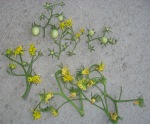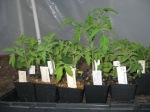But better late than never. It’s been so hectic that I’ve had to scale back on my ambitions for the giant tomato project. I’m just using the same 2’X33′ bed I’ve used for the past two years.
So on May 24th, I got some excellent help. We dug out the 2′ deep trench, added the amendments according to the ratios I formulated a few months ago, and got 11 very rootbound tomato “seedlings” out of their 4-gallon pots (where they had been biding their time for 111 days) and into the ground:
These are the 11 plants, from north to south:
Delicious (6.51 Meisner 2011) – Planted 12-24-2011
Brutus Magnum (6.25 Meisner 2011) – Planted 12-16-2011
MegaMarv (5.51 Meisner 2011) – Planted 12-16-2011
Big Zac (5.35 Lyons 2010) – Planted 12-16-2011
Delicious (4.46 Marley 2011) – Planted 12-24-2011
Big Zac? (4.20 Diaz 2011) – Planted 12-16-2011
Big Zac (3.94 Pennington 2010) – Planted 12-16-2011
Church (3.36 Perry 2008) – Planted 12-16-2011
Gildo Pietroboni (3 Kott 2011) – Planted 12-16-2011
Hoy (3 Kott 2011) – Planted 12-16-2011
Big Zac (2.660 DT 2011) – Planted 12-16-2011
Yes, that’s 160 days from seed to getting in the ground! The healthiest looking plant is Brutus Magnum, while the sickest (about half of leaves yellowed) is MegaMarv. Gildo Pietroboni had an amazing number of good-sized blossoms and small fruits. As last year, Big Zac (5.35 Lyons 2010) was putting out a lot of impressive megablooms with thick peduncles.
But I removed all the fruits and blossoms, along with the older leaves. Actually I quit removing blossoms from Big Zac? (4.20 Diaz 2011) when I realized that there has been a mixup of some sort: the blossoms and fruit appear to be producing large cherry tomatoes. See the pic showing the contrast in blossoms and young fruit, with the “4.20” blossoms above some mixed blossoms from the other plants.
Why halt their reproductive efforts? My objectives with this Phase 1 of the project are:
1. Encourage the plants to develop a massive and healthy root system. They are well on their way. The soil is rich, soft (I can push my arm in up to my elbow) and at least 25% organic matter. With mycorrhizal innoculant and lots of food for healthy microorganisms, I’m thinking the root systems will be massive in a couple of months.
2. Get huge plants that will be capable of producing plenty of energy to feed GIANT tomatoes. I’m guessing that by mid to late July, at least a few of these plants will be “over the top” of the poles – which are 12′ tall – and there will be an almost solid wall of green.
3. Allow fruits to set on megablooms between late July to early August so the fruits will mature by the late September weighoff. Once fruits set, I plan to terminate all vegetative growth. Theoretically, this should funnel all resources into the growing fruit – hopefully they won’t explode!
Phase 2 consists of 11 paired plants, grown from seeds of the same 11 tomatoes as phase 1. This is the “small plant, heavy prune” group. For these, I will employ the techniques used by most of the recent champion tomato growers – pruning to two stems, selecting a megabloom on one of the loweer trusses, toping off the plant at 6′ or so, etc.
One of the picks here shows the 11 seedlings for this phase, growing nicely inside a small hoophouse. These seeds were sown on 4-22-2012, so they are 35 days along. I hope to get them into the ground in a parallel bed within 2 weeks.







